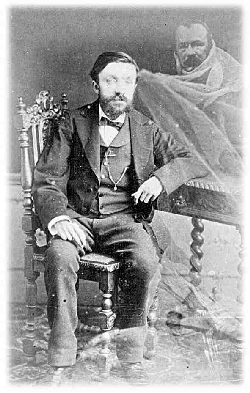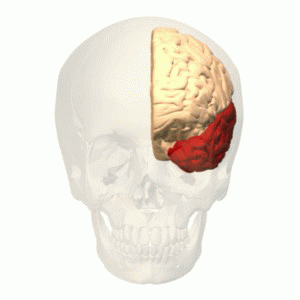|
God Helmet
The God helmet is an experimental apparatus (originally called the Coren helmet) developed by neuropsychological researcher Stanley Coren and neuroscientist Michael Persinger to study creativity, religious experience and the effects of subtle stimulation of the temporal lobes. Reports by participants of a "sensed presence" while wearing the God helmet brought public attention and resulted in several TV documentaries. The device has been used in Persinger's research in the field of neurotheology, the study of the purported neural correlates of religion and spirituality. The apparatus, placed on the head of an experimental subject, generates very weak magnetic fields, that Persinger refers to as "complex". Like other neural stimulation with low-intensity magnetic fields, these fields are approximately as strong as those generated by a land line telephone handset or an ordinary hair dryer, but far weaker than that of an ordinary refrigerator magnet and approximately a million times ... [...More Info...] [...Related Items...] OR: [Wikipedia] [Google] [Baidu] |
Stanley Coren
Stanley Coren (born 1942) is a psychology professor, neuropsychological researcher and writer on the intelligence, mental abilities and history of dogs. He works in research and instructs in psychology at the University of British Columbia in Vancouver, British Columbia. He writes for ''Psychology Today'' in the feature series Canine Corner. Background Coren was born in Philadelphia, Pennsylvania in 1942 to a secular Jewish family and attended undergraduate classes at the University of Pennsylvania before earning his doctorate at Stanford University. He went on to teach in The Graduate Faculty of The New School for Social Research in New York, New York before moving to the University of British Columbia in 1973, where he was a psychology professor and the Director of the Human Neuropsychology and Perception Laboratory until 2007. He teaches and researches as a professor emeritus and serves as an adjunct professor in the graduate program at Bergin University of Canine Studies. ... [...More Info...] [...Related Items...] OR: [Wikipedia] [Google] [Baidu] |
Parapsychology
Parapsychology is the study of alleged psychic phenomena (extrasensory perception, telepathy, teleportation, precognition, clairvoyance, psychokinesis (also called telekinesis), and psychometry (paranormal), psychometry) and other paranormal claims, for example, those related to near-death experiences, synchronicity, apparitional experiences, etc. Criticized as being a pseudoscience, the majority of mainstream scientists reject it. Parapsychology has been criticised for continuing investigation despite being unable to provide reproducible evidence for the existence of any psychic phenomena after more than a century of research. Parapsychology research rarely appears in mainstream scientific journals; a few niche journals publish most papers about parapsychology. Terminology The term ''parapsychology'' was coined in 1889 by philosopher Max Dessoir as the German . It was adopted by Joseph Banks Rhine, J. B. Rhine in the 1930s as a replacement for the term ''psychical research'' ... [...More Info...] [...Related Items...] OR: [Wikipedia] [Google] [Baidu] |
Fringe Science
Fringe science refers to ideas whose attributes include being highly speculative or relying on premises already Objection (argument), refuted. The chance of ideas rejected by editors and published outside the mainstream being correct is remote. When the general public does not distinguish between science and imitators, it risks exploitation, and in some cases, a "yearning to believe or a generalized suspicion of experts is a very potent incentive to accepting some pseudoscientific claims". The term "fringe science" covers everything from novel hypotheses, which can be tested utilizing the scientific method, to wild ad hoc hypotheses and Mumbo jumbo (phrase), mumbo jumbo. This has resulted in a tendency to dismiss all fringe science as the domain of Pseudoscience, pseudoscientists, hobbyists, and Quackery, quacks. A concept that was once accepted by the mainstream scientific community may become fringe science because of a later evaluation of previous research. For example, focal i ... [...More Info...] [...Related Items...] OR: [Wikipedia] [Google] [Baidu] |
Brain
The brain is an organ (biology), organ that serves as the center of the nervous system in all vertebrate and most invertebrate animals. It consists of nervous tissue and is typically located in the head (cephalization), usually near organs for special senses such as visual perception, vision, hearing, and olfaction. Being the most specialized organ, it is responsible for receiving information from the sensory nervous system, processing that information (thought, cognition, and intelligence) and the coordination of motor control (muscle activity and endocrine system). While invertebrate brains arise from paired segmental ganglia (each of which is only responsible for the respective segmentation (biology), body segment) of the ventral nerve cord, vertebrate brains develop axially from the midline dorsal nerve cord as a brain vesicle, vesicular enlargement at the rostral (anatomical term), rostral end of the neural tube, with centralized control over all body segments. All vertebr ... [...More Info...] [...Related Items...] OR: [Wikipedia] [Google] [Baidu] |
Individual Differences
Differential psychology studies the ways in which individuals differ in their behavior and the processes that underlie it. It is a discipline that develops classifications ( taxonomies) of psychological individual differences. This is distinguished from other aspects of psychology in that, although psychology is ostensibly a study of individuals, modern psychologists often study groups, or attempt to discover general psychological processes that apply to all individuals. This particular area of psychology was first named and still retains the name of "differential psychology" by William Stern in his 1900 book "''Über Psychologie der individuellen Differenzen''" (On the Psychology of Individual Differences). While prominent psychologists, including Stern, have been widely credited for the concept of differential psychology, historical records show that it was Charles Darwin (1859) who first spurred the scientific interest in the study of individual differences. The interest was ... [...More Info...] [...Related Items...] OR: [Wikipedia] [Google] [Baidu] |
Temporal Lobe
The temporal lobe is one of the four major lobes of the cerebral cortex in the brain of mammals. The temporal lobe is located beneath the lateral fissure on both cerebral hemispheres of the mammalian brain. The temporal lobe is involved in processing sensory input into derived meanings for the appropriate retention of visual memory, language comprehension, and emotion association. ''Temporal'' refers to the head's temples. Structure The temporal lobe consists of structures that are vital for declarative or long-term memory. Declarative (denotative) or explicit memory is conscious memory divided into semantic memory (facts) and episodic memory (events). The medial temporal lobe structures are critical for long-term memory, and include the hippocampal formation, perirhinal cortex, parahippocampal, and entorhinal neocortical regions. The hippocampus is critical for memory formation, and the surrounding medial temporal cortex is currently theorized to be critical f ... [...More Info...] [...Related Items...] OR: [Wikipedia] [Google] [Baidu] |
Religious Experience
A religious experience (sometimes known as a spiritual experience, sacred experience, mystical experience) is a subjectivity, subjective experience which is interpreted within a religious framework. The concept originated in the 19th century, as a defense against the growing rationalism of Western world, Western society. William James popularised the concept. In some religions, this is said to sometimes result in unverified personal gnosis. Many religious and mystical traditions see religious experiences (particularly the knowledge which comes with them) as revelations caused by divine agency rather than ordinary natural processes. They are considered real encounters with God or gods, or real contact with higher-order realities of which humans are not ordinarily aware. Skeptics may hold that religious experience is an evolved feature of the human brain amenable to normal scientific study. The commonalities and differences between religious experiences across different cultures ... [...More Info...] [...Related Items...] OR: [Wikipedia] [Google] [Baidu] |
Neuroscience Letters
''Neuroscience Letters'' is a biweekly rapid-publication scientific journal for short articles covering all aspects of neuroscience. According to the ''Journal Citation Reports'', ''Neuroscience Letters'' has a 2020 impact factor The impact factor (IF) or journal impact factor (JIF) of an academic journal is a type of journal ranking. Journals with higher impact factor values are considered more prestigious or important within their field. The Impact Factor of a journa ... of 3.046. References Neuroscience journals Elsevier academic journals Academic journals established in 1975 English-language journals Biweekly journals {{neuroscience-journal-stub ... [...More Info...] [...Related Items...] OR: [Wikipedia] [Google] [Baidu] |
Double-blind
In a blind or blinded experiment, information which may influence the participants of the experiment is withheld until after the experiment is complete. Good blinding can reduce or eliminate experimental biases that arise from a participants' expectations, Observer-expectancy effect, observer's effect on the participants, observer bias, confirmation bias, and other sources. A blind can be imposed on any participant of an experiment, including subjects, researchers, technicians, data analysts, and evaluators. In some cases, while blinding would be useful, it is impossible or unethical. For example, it is not possible to blind a patient to their treatment in a physical therapy intervention. A good clinical protocol ensures that blinding is as effective as possible within ethical and practical constraints. During the course of an experiment, a participant becomes #Unblinding, unblinded if they deduce or otherwise obtain information that has been masked to them. For example, a patient w ... [...More Info...] [...Related Items...] OR: [Wikipedia] [Google] [Baidu] |
Sweden
Sweden, formally the Kingdom of Sweden, is a Nordic countries, Nordic country located on the Scandinavian Peninsula in Northern Europe. It borders Norway to the west and north, and Finland to the east. At , Sweden is the largest Nordic country by both area and population, and is the List of European countries by area, fifth-largest country in Europe. Its capital and largest city is Stockholm. Sweden has a population of 10.6 million, and a low population density of ; 88% of Swedes reside in urban areas. They are mostly in the central and southern half of the country. Sweden's urban areas together cover 1.5% of its land area. Sweden has a diverse Climate of Sweden, climate owing to the length of the country, which ranges from 55th parallel north, 55°N to 69th parallel north, 69°N. Sweden has been inhabited since Prehistoric Sweden, prehistoric times around 12,000 BC. The inhabitants emerged as the Geats () and Swedes (tribe), Swedes (), who formed part of the sea-faring peopl ... [...More Info...] [...Related Items...] OR: [Wikipedia] [Google] [Baidu] |
Uppsala University
Uppsala University (UU) () is a public university, public research university in Uppsala, Sweden. Founded in 1477, it is the List of universities in Sweden, oldest university in Sweden and the Nordic countries still in operation. Initially founded in the 15th century, the university rose to significance during the rise of Swedish Empire, Sweden as a great power at the end of the 16th century and was then given relative financial stability with a large donation from Monarchy of Sweden, King Gustavus Adolphus of Sweden, Gustavus Adolphus in the early 17th century. Uppsala also has an important historical place in Swedish national culture, and national identity, identity for the Swedish establishment: in historiography, religion, literature, politics, and music. Many aspects of Swedish academic culture in general, such as the white student cap, originated in Uppsala. It shares some peculiarities, such as the student nation system, with Lund University and the University of Helsink ... [...More Info...] [...Related Items...] OR: [Wikipedia] [Google] [Baidu] |
Psychologist
A psychologist is a professional who practices psychology and studies mental states, perceptual, cognitive, emotional, and social processes and behavior. Their work often involves the experimentation, observation, and explanation, interpretation of how individuals relate to each other and to their environments. Psychologists usually acquire a bachelor's degree in psychology, followed by a master's degree or doctorate in psychology. Unlike psychiatrist, psychiatrists and psychiatric nurse-practitioners, psychologists usually cannot prescribe medication, but depending on the jurisdiction, some psychologists with additional training can be licensed to prescribe medications; qualification requirements may be different from a bachelor's degree and master's degree. Psychologists receive extensive training in psychological testing, communication techniques, scoring, interpretation, and reporting, while psychiatrists are not usually trained in psychological testing. Psychologists are a ... [...More Info...] [...Related Items...] OR: [Wikipedia] [Google] [Baidu] |





